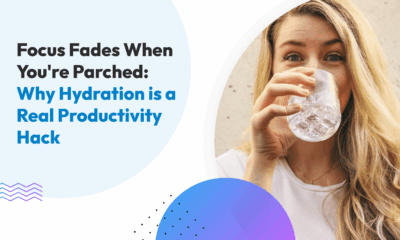Science Says
The Brain’s ‘Precision Mode’ Could be the Key to Unlocking Your Next Level of Success
As business owners, we don’t think about many of the things we do and decisions we make as “learning”. But it turns out, “learning” is related to a lot more than studying the latest software help files from preparing for meetings to building sales strategies and more.
Most advice emphasizes putting in more hours, more practice, and more repetition to get results. However, recent research examining how brains store and process information suggests that precision and quality may be more important than we thought. The study, published in Neural Computation, analyzed brain tissue from rats to understand how neurons efficiently store information through precise, systematic processes rather than brute force repetition. While conducted in rats, it offers clues about human brain function. Rats and humans share approximately 90% of their genes, so the findings are relevant to us as business owners and freelancers who need to continuously learn, adapt, and perform at high levels.
What This Means for Your Performance
Precision Mode in Practice
The study’s findings about precision have important implications for how business owners approach learning. Researchers found that the coefficient of variation—a measure of consistency and accuracy—was consistent across different neural connections. This suggests our brains are optimized for steady, focused learning rather than sporadic bursts of activity.
Consider two scenarios: A business owner reading a market analysis report during a rushed taxi ride to a meeting versus reviewing the same material during a focused morning session. This research suggests that the latter approach—consistent, focused learning—helps store information more precisely and makes it easier to recall later.
Similarly, imagine a business owner implementing new accounting software. They could schedule one intensive 8-hour training day or break the learning into 45-minute daily sessions over two weeks. Research suggests neural pathways work better with the consistent, shorter sessions, as they allow the brain to process information in alignment with its natural storage mechanisms.
Action Item: Create a consistent learning routine that matches your peak cognitive hours. Document your energy levels and learning effectiveness throughout the day for two weeks to identify your optimal learning windows.

Information Organization and Brain Storage Patterns
The study found synapses are capable of maintaining approximately 24 distinct strength levels, storing about 4.1 bits of information per synapse. Researchers also found these strength levels were distributed with “a near maximal efficiency” – achieving an 89% efficiency ratio in information storage.
This means our brains manage complex information in a streamlined and efficient way. Just as our brains don’t need to consciously track all 24 different strength levels to function effectively, our business systems can also handle complexity with simple structures.
Consider how a venture capitalist evaluates investment opportunities. While they might use a simple “yes/no/maybe” filing system for organizing proposals, their actual evaluation process incorporates multiple factors – market size, team capability, product differentiation, etc. The simple categorization system lets them focus on evaluating opportunities instead of getting bogged down in organization.
Or think about how successful restaurants handle food quality control. Despite the complexity of food preparation, many use a straightforward “use now/use soon/discard” system for ingredients. This simplicity frees up mental energy for more important tasks like cooking and customer service.
Action Item: Identify 2-3 key areas in your business where nuanced thinking matters most (like pricing strategy or client relationships). For these areas, keep your organization simple but develop detailed evaluation criteria. For example, keep your basic client categories simple (active/inactive/prospect) while using a more nuanced approach in your actual client interactions and strategy development.
Quality of Processing and Retrieval Strength
The study also gave insight into how information gets stored in our brains: the better you focus when learning something, the easier it is to recall.
This explains why two business owners can attend the same conference but come away with vastly different levels of actionable knowledge. Consider a presentation about emerging market trends: One owner might check emails while half-listening, while another takes focused notes and immediately identifies three ways the information applies to their business (action items in note-taking also help notes not go into a folder or shelf to die). According to the research, the second approach creates stronger, more usable brain connections for retrieving the information later.
The same principle appears in sales contexts. A salesperson who quickly skims a prospect’s website minutes before a call will likely retain less usable information than one who spends 15 focused minutes researching and making specific connections to their product’s benefits. This isn’t just about having more information—it’s about how well it’s encoded for use during the call.
Action Item: Before any important business interaction or learning opportunity, create a 15-minute “processing window.” Write down key points and one way to apply them to your business. This aligns with how your brain naturally converts information into accessible knowledge.

Optimizing Brain States for Information Precision
The study showed that when the precision of synaptic strengths is low, the amount of information that can be stored in the ensemble of the neurons will also be low. So our brain’s ability to store and retrieve information depends on achieving optimal conditions for precision.
This finding could help explain why certain brain states may work better for different business activities. Just as synaptic strength must be precise for effective information storage, different mental tasks may require different optimal brain conditions. Consider financial analysis versus creative brainstorming. We might struggle with creative marketing ideas when attempting to brainstorm right after detailed budget analysis because our brain isn’t in the right state for creative work.
We might notice we process certain types of information more precisely in specific settings or at certain times of day. Some find they can store and retrieve strategic information more effectively during their morning walk, while detailed operational information might be processed more precisely during focused office time. This isn’t just personal preference; it aligns with how the brain stores and retrieves information best.
Action Item: Create “high precision” zones in your schedule – 60-90 minute blocks for different types of work based on your mental energy. For example, schedule creative work during your most energetic times, analytical tasks during your most focused times, and strategic thinking during periods when you tend to see the bigger picture most clearly.
Pattern Recognition and Information Integration
The study found that our brains are naturally designed to recognize patterns and connect related pieces of information. For example, when two parts of a brain cell are repeatedly activated by the same input, they strengthen their connection over time. This means our brains are built to link similar experiences or pieces of information, helping us see patterns more easily.
A seasoned real estate investor, for instance, might quickly recognize how rising interest rates, construction costs, and rental demand interconnect to create market opportunities. It’s not just about knowing each piece of information, the ability to connect these pieces stems from the brain strengthening patterns through experience.
An experienced support manager can often identify the root cause of a customer issue faster than a novice, not because they know more facts, but because their brain has built stronger connections between similar past scenarios and solutions. This pattern recognition is physically encoded in the brain over time.
Action Item: Build “pattern recognition time” into your analysis of business data. After reviewing individual metrics or reports, spend 15 minutes identifying how the data might connect across different areas of your business. For example, after reviewing sales data and customer feedback separately, spend 15 minutes exploring how they might be interconnected.

Information Capacity and Decision Making
How much information can we actually hold? While our brains can maintain approximately 24 distinct strength levels per synapse, storing about 4.1 bits of information, they do this with “near maximal efficiency.” This suggests our brains optimize information storage rather than simply maximizing it.
Consider you’re researching new software solutions. Trying to analyze 20 options in detail may lead to worse decisions than narrowing to three candidates for deeper analysis. While it might seem counterintuitive, the research suggests our brains process information more effectively when working within their optimal capacity rather than at maximum load.
We see this play out in product development too. Companies like Apple are famous for maintaining focused product lines rather than offering endless options. While competitors might offer 30 different smartphone models, Apple typically maintains a streamlined lineup. This strategy aligns with the brain’s preference for manageable choices.
Action Item: When facing complex business decisions, start by filtering options using simple criteria (3-5 choices) before doing a deeper evaluation. For example, when looking for a new bookkeeping software for your business, use basic requirements to screen a small list before conducting thorough evaluations.
Study Limitations
The study’s primary limitation is its focus on rat brain tissue samples, specifically examining the hippocampus region. While rodent models are widely used and validated for understanding basic neural mechanisms, human brain complexity may alter how these findings apply. The sample size was relatively small, analyzing 288 synaptic connections from a specific brain region. Additionally, the research focused on the physical structure of memory storage rather than observing how learning happens in real time. The study also did not link structural changes to behavior.
Wrap Up
The research reveals that mammalian brains use highly efficient processes for storing information, achieving nearly 90% efficiency in how synapses encode information. For business owners, this suggests that focusing on the quality and precision of our learning approaches may be more valuable than simply putting in more hours or repetitions. Just as our brains optimize information storage through systematic precision rather than brute force, we may achieve better results by emphasizing structured, precise learning methods over sheer quantity of practice or study time.
Whether developing new skills, training employees, or maintaining our own expertise, these findings remind us that “how” we learn often matters more than “how much.” Applying these principles can help us achieve better results with less wasted time and effort, the very definition of productivity!












